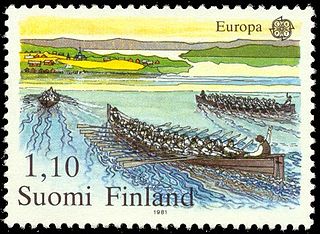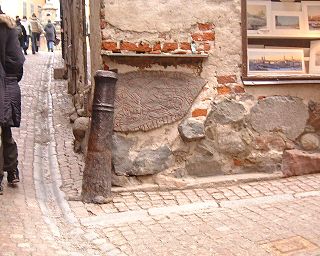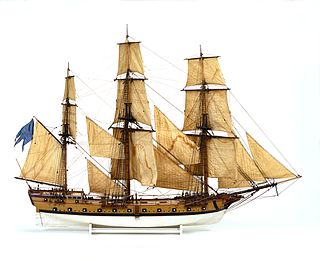
Mälaren, historically referred to as Lake Malar in English, is the third-largest freshwater lake in Sweden. Its area is 1,140 km2 and its greatest depth is 64 m. Mälaren spans 120 kilometers from east to west. The lake drains, from south-west to north-east, into the Baltic Sea through its natural outlets Norrström and Söderström and through the artificial Södertälje Canal and Hammarbyleden waterway. The easternmost bay of Mälaren, in central Stockholm, is called Riddarfjärden. The lake is located in Svealand and bounded by the provinces of Uppland, Södermanland and Västmanland. The two largest islands in Mälaren are Selaön (91 km2) and Svartsjölandet (79 km2). Mälaren is low-lying and mostly relatively shallow.

Rowing, sometimes called crew in the United States, is the sport of racing boats using oars. It differs from paddling sports in that rowing oars are attached to the boat using oarlocks, while paddles are not connected to the boat. Rowing is divided into two disciplines: sculling and sweep rowing. In sculling, each rower holds two oars—one in each hand, while in sweep rowing each rower holds one oar with both hands. There are several boat classes in which athletes may compete, ranging from single sculls, occupied by one person, to shells with eight rowers and a coxswain, called eights. There are a wide variety of course types and formats of racing, but most elite and championship level racing is conducted on calm water courses 2 kilometres (1.2 mi) long with several lanes marked using buoys.

The history of Stockholm, capital of Sweden, for many centuries coincided with the development of what is today known as Gamla stan, the Stockholm Old Town. Stockholm's raison d'être always was to be the Swedish capital and by far the largest city in the country.

Ekerö Municipality is a municipality in the province of Uppland in Stockholm County in east central Sweden. The name derives from the name of the main island within the municipality whose name is Ekerön, and literally means "Oak Island". Its seat is located in the town of Ekerö.

The City of Stockholm is situated on fourteen islands and on the banks to the archipelago where Lake Mälaren meets the Baltic Sea. The city centre is virtually situated on the water.

The gondola is a traditional, flat-bottomed Venetian rowing boat, well suited to the conditions of the Venetian lagoon. It is typically propelled by a gondolier, who uses a rowing oar, which is not fastened to the hull, in a sculling manner and also acts as the rudder. The uniqueness of the gondola includes its being asymmetrical along the length making the single-oar propulsion more efficient.

The history of rowing as a sport has prevailed it as one of the oldest traditions in the world. What began as a method of transport and warfare eventually became a sport with a wide following, and a part of the cultural identity of the English speaking world. Rowing in its modern form developed in England in the 1700s.

Strömsborg is a small islet in central Stockholm, Sweden, located north of Stadsholmen, and west of Helgeandsholmen, between the bridges Centralbron, a motorway passing through central Stockholm, and Vasabron. Administratively, Strömsborg is part of Gamla stan, the old town of Stockholm and is connected to the rest of the city by the bridge Strömsborgsbron leading over to Vasabron.

The prehistory of Stockholm is the continuous development and series of events that made the mouth of Lake Mälaren strategically important; a location which by the mid 13th century had become the centre of the newly consolidated Swedish kingdom. The origin of Stockholm pre-dates its written history, and several mythological stories and modern myths have attempted to explain both its emergence and its name.

The architecture of Stockholm has a history that dates back to the 13th century, possibly even earlier. According to some sources, there might have been a simple defense structure, perhaps a small castle, on the northeast part of the island Stadsholmen. Buildings in Stockholm are characterized by their unique location between Lake Mälaren and the Baltic Sea. The Hanseatic League during the great period of industrialization saw a strong desire to modernize the city.

An udema, also udenma, was a type of warship built for the Swedish archipelago fleet in the late 18th and early 19th centuries. It was developed for warfare in the Archipelago Sea in the Baltic and along the coasts of Svealand and Finland against the Russian navy. The udema was designed by the prolific naval architect Fredrik Henrik af Chapman for use in an area of mostly shallow waters and groups of islands and islets that extend from Stockholm all the way to the Gulf of Finland.

A hemmema was a type of warship built for the Swedish archipelago fleet and the Russian Baltic Fleet in the late 18th and early 19th centuries. The hemmema was initially developed for use against the Imperial Russian Navy in the Archipelago Sea and along the coasts of Svealand and Finland. It was designed by the prolific and innovative Swedish naval architect Fredrik Henrik af Chapman (1721–1808) in collaboration with Augustin Ehrensvärd (1710–1772), an artillery officer and later commander of the Swedish archipelago fleet. The hemmema was a specialized vessel for use in the shallow waters and narrow passages that surround the thousands of islands and islets extending from the Swedish capital of Stockholm into the Gulf of Finland.

The status and rights of Women in Sweden has changed several times throughout the history of Sweden. These changes have been affected by the culture, religion and laws of Sweden, as well as social discourses like the strong feminist movement.

Events from the year 1862 in Sweden

Events from the year 1875 in Sweden

Events from the year 1848 in Sweden

Events from the year 1741 in Sweden
1720 års skråordning was a law reform introduced in Sweden in 1720. It replaced the 1669 års allmänna skråordning and, with additional modifications, regulated the guild system and business life in Sweden until the Fabriks och Handtwerksordning and Handelsordningen of 1846.

Storskär is a steamship that was built in 1908 in Gothenburg. She was originally named Strängnäs Express and traded between Stockholm and Strängnäs on Lake Malaren. She was transferred to service on the Stockholm archipelago in 1939, and given her current name in the following year. Storskär has operated for Waxholmsbolaget and her predecessors since 1939, and is today one of that company's classic fleet, alongside Norrskär and Västan. She is a listed historical ship of Sweden.

Västan is a motor vessel, and former steam ship, that was built in 1900 in Motala. She was originally named Nya Svartsjölandet and traded between Stockholm and Slut on Lake Mälaren. She was sold to Waxholmsbolaget for use in the Stockholm archipelago in 1937 and renamed Västan. She was converted to diesel power in 1953. The Västan is today the oldest of Waxholmsbolaget's classic fleet, operating alongside Storskär and Norrskär which, although newer, have retained their original steam propulsion. She is a listed historic ship of Sweden.



















